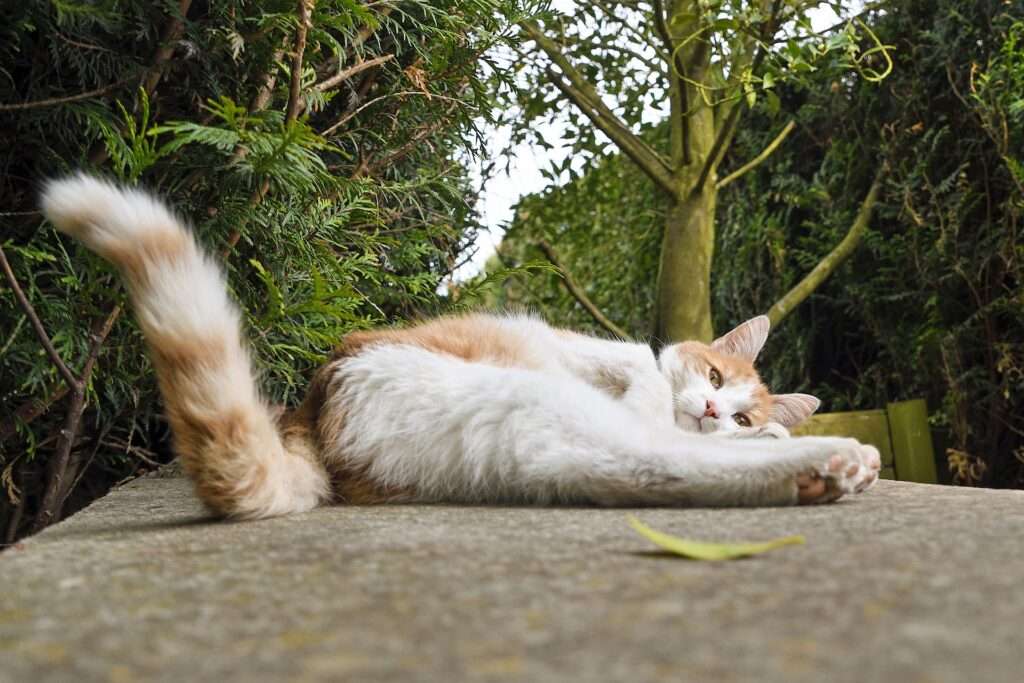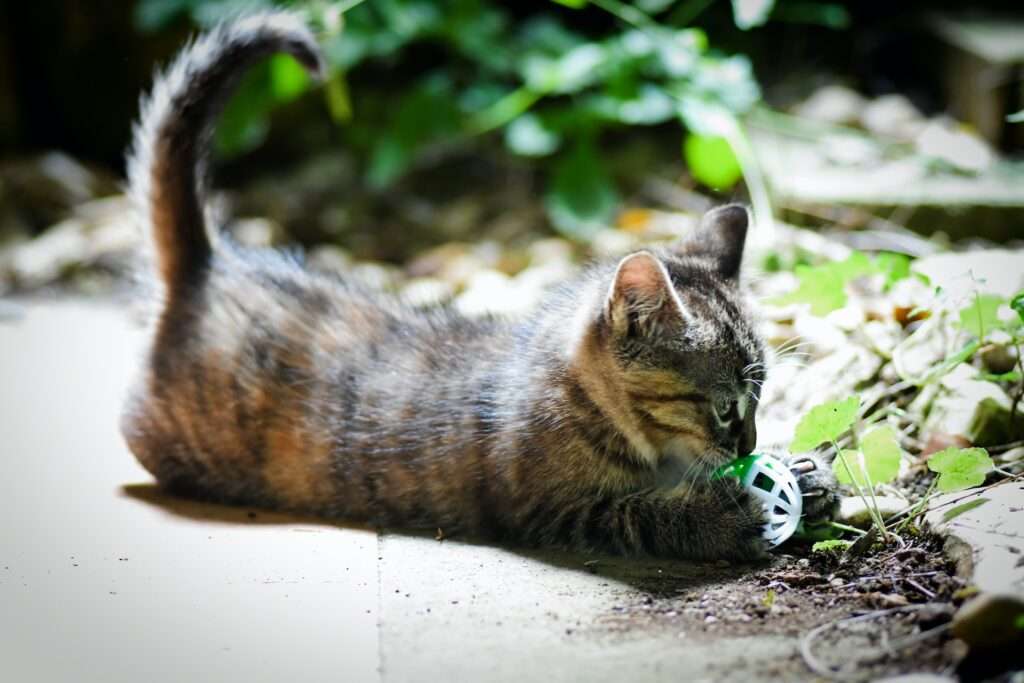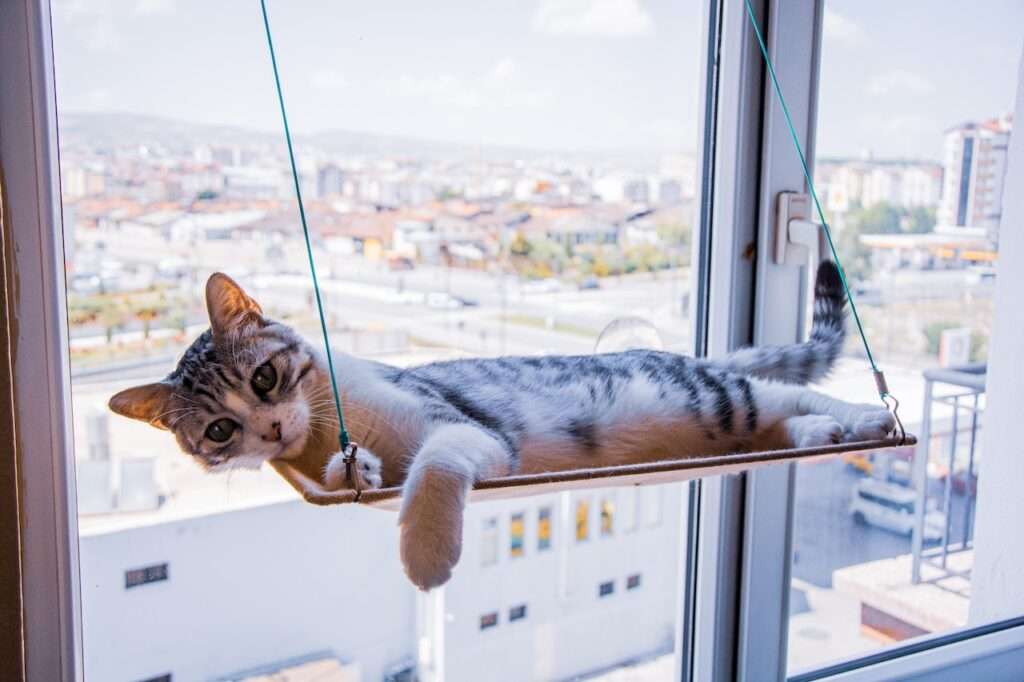Why Do Cats Wag Their Tails While Lying Down? The Fascinating Truth
Welcome to BarkLikeMeow, the ultimate guide for pet parents! In this article, we will explore the fascinating behavior of cats, and specifically, why do cats wag their tails while lying down.
As a cat parent, you may have observed this behavior in your furry companion and wondered about its significance. We have conducted extensive research and consulted with experts to bring you the most comprehensive and up-to-date information on this topic.
Cats are fascinating creatures, and their behavior is often shrouded in mystery. However, understanding their behavior is crucial for responsible pet ownership. In this article, we will delve into the world of feline communication, the role of the tail in this communication, and the different types of tail movements in cats.
Understanding Feline Communication
Feline communication is complex and multifaceted, and understanding it is essential for interpreting your cat’s behavior. Cats communicate in a variety of ways, including vocalizations, body language, and scent marking. Of these, body language is the most expressive and easily observable.
The tail is an important component of feline body language, and cats use it to communicate a range of emotions, from happiness and contentment to fear and aggression. Understanding the different types of tail movements in cats is crucial for interpreting their behavior accurately.
As pet parents, it’s important to pay attention to your cat’s body language to ensure their well-being and happiness. By understanding feline communication, you can build a stronger bond with your cat and provide them with the love and care they deserve.
The Different Types of Tail Movements in Cats

Cats have a diverse range of tail movements, and each movement has its own meaning. Some of the most common types of tail movements in cats include flicking, twitching, lashing, waving, and puffing.
- Flicking: This is a rapid movement of the tail that is usually a sign of agitation or annoyance. Your cat may flick their tail when they are feeling threatened or when they want to be left alone.
- Twitching: This is a slight movement of the tail that usually indicates excitement or anticipation. Your cat may twitch their tail when they are getting ready to pounce on a toy or chase a mouse.
- Lashing: This is a violent movement of the tail that is usually a sign of anger or aggression. Your cat may lash their tail when they are feeling threatened or when they are in a confrontational situation with another cat.
- Waving: This is a slow, sweeping movement of the tail that is usually a sign of contentment or relaxation. Your cat may wave their tail when they are lying down and feeling comfortable and happy.
- Puffing: This is a fluffed-up, puffy appearance of the tail that is usually a sign of fear or anxiety. Your cat may puff their tail when they are feeling threatened or when they are in an unfamiliar or uncomfortable environment.
Why Do Cats Wag Their Tails While Lying Down?
Wagging of the tail is a common behavior in dogs, but it is not as well understood in cats. While cats do not wag their tails in the same way that dogs do, they may still exhibit tail movements while lying down.
There are several possible reasons why cats wag their tails while lying down. One possible explanation is that it is a sign of contentment and relaxation. Your cat may wag their tail when they are feeling comfortable and happy in their environment.
Another possible explanation is that it is a sign of excitement or anticipation. Your cat may wag their tail when they are getting ready to play with a toy or when they are anticipating a treat.
It’s important to note that the context of your cat’s behavior is crucial for interpreting their tail movements accurately. A wagging tail may have different meanings depending on the situation and your cat’s body language as a whole.
In the next part of our article, we will explore some of the medical and behavioral reasons why cats may wag their tails while lying down, and what you can do to help them.
Medical Reasons for Tail Wagging in Cats
While tail wagging in cats is often a normal behavior, there are some medical conditions that may cause excessive tail wagging or abnormal tail movements. These medical conditions may include:
- Pain: Cats may wag their tails while lying down as a sign of pain or discomfort. If your cat is exhibiting other signs of pain, such as vocalizing or limping, it’s important to take them to the veterinarian for a check-up.
- Neurological disorders: Some neurological disorders, such as epilepsy or nerve damage, may cause abnormal tail movements in cats. If your cat is exhibiting other signs of neurological issues, such as seizures or loss of coordination, it’s important to seek veterinary care.
- Hyperthyroidism: Hyperthyroidism is a common condition in older cats that may cause excessive tail wagging, among other symptoms. If you suspect your cat has hyperthyroidism, consult with your veterinarian for treatment options.
It’s important to monitor your cat’s behavior and seek veterinary care if you suspect any medical issues.
Behavioral Reasons for Tail Wagging in Cats

In addition to medical reasons, there are several behavioral reasons why cats may wag their tails while lying down. These may include:
- Playfulness: Cats may wag their tails while lying down as a sign of playfulness or excitement. If your cat is exhibiting other playful behaviors, such as chasing toys or pouncing, it’s likely that their tail wagging is a sign of happiness and contentment.
- Social communication: Cats use their tails to communicate with other cats, and tail wagging may be a sign of social communication. If your cat is wagging their tail while interacting with another cat, it’s important to monitor their body language and ensure that the interaction is positive.
- Stress or anxiety: Cats may wag their tails while lying down as a sign of stress or anxiety. If your cat is exhibiting other signs of stress, such as hiding or vocalizing, it’s important to identify and address the source of their stress.
By understanding the different types of tail movements and the possible medical and behavioral reasons for tail wagging in cats, you can better understand and communicate with your furry friend.
Interpreting the Tail Wagging Behavior in Your Cat
Interpreting your cat’s tail wagging behavior can be tricky, as different tail movements can mean different things. Here are some common tail movements and their meanings:
- Slow and gentle tail swishing: This is a sign that your cat is relaxed and content.
- Rapid and aggressive tail wagging: This may indicate that your cat is feeling threatened or agitated.
- Puffed-up tail: A puffed-up tail is a sign that your cat is feeling fearful or threatened.
- Tail held high: A tail held high is a sign that your cat is feeling confident and happy.
- Tail tucked between legs: This is a sign that your cat is feeling scared or submissive.
It’s important to consider your cat’s body language as a whole when interpreting their tail movements, as well as their surroundings and other factors that may be influencing their behavior.
How to Respond to Your Cat’s Tail Wagging
If your cat is wagging their tail while lying down, it’s important to respond appropriately to their behavior. Here are some tips to keep in mind:
- Pay attention to the context: Tail wagging can have different meanings depending on the situation. Take note of any other body language signals or environmental factors that may be contributing to your cat’s behavior.
- Avoid triggering your cat: If your cat is wagging their tail aggressively, try to identify any potential triggers and remove them if possible. This may include loud noises, unfamiliar people or animals, or changes in routine.
- Redirect their attention: If your cat is exhibiting aggressive tail wagging, try distracting them with a toy or treat. This can help redirect their attention and diffuse the situation.
- Consult with a veterinarian: If your cat is exhibiting unusual tail behavior or other unusual symptoms, it’s important to consult with a veterinarian to rule out any potential health issues.
How to Help Your Cat with Tail Wagging Issues

If your cat’s tail wagging behavior is causing concern or discomfort, there are several things you can do to help them:
- Provide a safe and comfortable environment: Ensure that your cat has a comfortable and safe space to relax in, with plenty of toys and activities to keep them occupied.
- Address any medical issues: If you suspect that your cat’s tail wagging behavior is due to a medical issue, consult with your veterinarian to identify and treat the underlying condition.
- Address any behavioral issues: If your cat’s tail wagging behavior is due to stress or anxiety, identify and address the source of their stress, and consider behavioral training or medications if necessary.
- Give your cat plenty of attention and affection: Cats thrive on attention and affection from their owners, so make sure to spend plenty of quality time with your furry friend.
By taking these steps, you can help your cat feel more comfortable and happy, and reduce any negative tail wagging behavior they may be exhibiting.
Conclusion
Cats are fascinating creatures with their own unique set of behaviors and body language. Tail wagging while lying down is a common behavior in cats, and can indicate a range of emotions, from happiness and playfulness to stress and anxiety.
By understanding the different types of tail movements and the possible medical and behavioral reasons for tail wagging in cats, you can better understand and communicate with your furry friend. If you notice any abnormal tail movements or behaviors in your cat, it’s important to monitor their behavior and seek veterinary care if necessary.
Remember, your cat’s tail movements are just one aspect of their body language, and it’s important to consider their behavior as a whole when interpreting their actions. With love, patience, and understanding, you can help your cat feel comfortable and happy, and strengthen the bond between you and your feline companion.
Frequently Asked Questions
Why do cats wag their tails while lying down?
Cats can wag their tails while lying down for a variety of reasons. It could be a sign of agitation, annoyance, excitement, anticipation, playfulness, or happiness. The type of tail movement can also indicate different emotions. For example, a rapid flick of the tail usually means agitation or annoyance, while a gentle swaying or wagging of the tail can indicate happiness and contentment.
Is tail wagging always a good sign?
Not necessarily. As mentioned, tail wagging can indicate different emotions, and a rapid flicking of the tail can mean that the cat is feeling threatened or wants to be left alone. It’s important to observe the cat’s body language and other behaviors to determine their overall mood and whether they’re comfortable with interaction.
What should I do if my cat wags their tail aggressively?
If your cat is flicking their tail rapidly or aggressively, it’s best to give them some space and avoid interaction until they calm down. This could be a sign of agitation or annoyance, and attempting to pet or play with them could escalate the situation. Observe their behavior and try to identify the source of their discomfort. If the behavior persists or becomes more frequent, it may be worth consulting with a veterinarian or animal behaviorist.
Can tail wagging be a sign of illness?
In some cases, yes. Tail wagging or twitching can be a symptom of certain medical conditions, such as neurological disorders or pain. However, it’s important to consider other factors and observe the cat’s overall behavior and health before jumping to conclusions. If you’re concerned about your cat’s tail movements or any other symptoms, it’s best to consult with a veterinarian for a proper diagnosis.
Can cats wag their tails while they sleep?
No, cats typically do not wag their tails while they’re asleep. Tail movements are usually a sign of conscious behavior and emotion.
What other tail movements should I look out for in cats?
In addition to wagging, cats can also twitch, fluff, tuck, or hold their tails in different positions to communicate different emotions. For example, a puffed-up tail can indicate fear or aggression, while a tucked tail can indicate submission or anxiety.
Do all cats wag their tails?
No, not all cats wag their tails. Some cats may have different ways of communicating their emotions or may not be as expressive with their tails.
Can tail wagging be a sign of playfulness?
Yes, tail wagging can be a sign of playfulness in cats. When cats are in a playful mood, they may wag their tails gently as a way of inviting interaction.
Why do cats sometimes wag their tails while they’re eating?
Cats may wag their tails while they’re eating as a sign of contentment or pleasure. However, it’s important to make sure that the cat isn’t experiencing any discomfort or pain while eating, as this could also cause tail movements.
Can tail wagging be a sign of affection?
Yes, tail wagging can be a sign of affection in cats. When cats are happy and content, they may wag their tails gently as a way of showing their affection towards their owners or other cats.
What does it mean when a cat flicks its tail while lying down?
When a cat flicks its tail while lying down, it often signifies irritation, displeasure, or a desire to be left alone. This rapid tail movement can be a clear indicator that the cat is not in a receptive or comfortable state, and it’s advisable to respect their space to avoid potential agitation.



